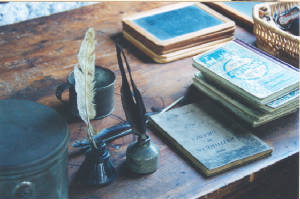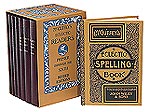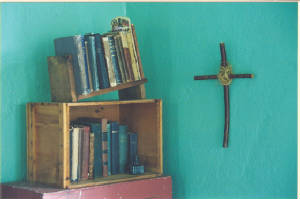|
...for one thing, MOST schools in Minnesota during the Civil War were JUST ONE ROOM! No seperate lunch room, auditorium, classrooms,
gyms or anything. Just one room, with all the grades taught in the school (some schools taught more and others fewer grades.
It depended upon where you were in Minnesota, and how educated your teacher was!)sitting together in desks. Boys and girls
usually sat on opposite sides of the room, with the youngest students at the front and the oldest students (there was not
a requirement for age per grade in many places, so much older students sometimes occupied the same grade as much younger students)at
the rear of the room. One teacher usually ran the school, with some lessons being taught to the WHOLE room and others that
would be given to individual grades one at a time. While this may all seem odd to us, and maybe not a good way to get an education,
many 19th century children who attended such schools did quite well. In addition, WHAT students studied was different from
what you might learn today. Students learned many things you do; math (called arithmetic), reading and handwriting, geography
(or where things are), history, and some basic science. But in addition, they also would have had bible lessons (church and
schools were much less seperate than they are in your time); Citizenship lessons (on how to be a good American), some would
have had Philosophy (the study of ideas and thoughts), Rhetoric (which is writing and speaking in public, like a speech class);
and some kids might not even learn all of this in English! Depending upon what sorts of people lived where you were living,
you might have been taught in German AND English.

In the this school, you wouldn't have a locker-or really even a desk of your own. You shared your desk, and would have to
carry your papers and books to and from school everyday (they didn't have backpacks yet for school children either). Until
you got into the upper grades, you would use pencil (they don't have erasers yet though-so dont make mistakes!) or chalk and
a slate (as SLATE is a small blackboard) to do your assignments on. Once you got to the upper grades, you would start using
pen and ink. Most of your homework would be reading chapters in the books assigned by your school (such as the McGuffey's
Reader), and then sitting down with the teacher and discussing what the reading was about (so no way to fake your way through
that!). Oh,and don't go thinking you can mess about in class! In a 19th Century Minnesota schoolhouse, the teacher CAN SPANK
or even HIT YOU WITH A STICK (called a switch) for being bad!

Still, it's better than working all day-right? Kids would bring their own lunches (because the school lunch hasn't been invented
for the most part yet)in a tied up handkerchief or even a tin pail (in the picture above, you can see a lunch pail on the
lower left side of the desk). Your lunch would probably depend upon what was around at home, but LARD SANDWHICHES weren't
uncommon (yum!). Many times there would be some time to play outside during he school day as well, and some kids might even
go home in the middle of the day to tend to chores btween classes! In every schoolhouse, there would always be a picture of
George Washington-founding father and very first President of the United States. After the Civil War (when he has been shot
and killed by John Wilkes Booth) Abraham Lincoln's picture would also be found in every schoolhouse, hanging right next to
Washington's. The teacher (usually a woman, because such work was considered to be very poor for a man-even though male teachers
were paid a lot more than females were!)would often take turns living with her pupils through the year as part of her pay.
Can you imagine having to go home and have dinner with your teacher?

The big thing to remember about school in the 19th Century is that kids did whatever they could to get there. It is known
that some children would walk MILES just to go to school (even in the winter, since Schoolbuses haven't been invented yet!).
And even with such willingness to go to school, many many children (especially in the big cities of the Eastern United States)
never were able to attend school. Sometimes kids might even have to quit school to help their families pay bills, or supply
food. But that was just the way things were in those days, in Minnesota during the Civil War.
|